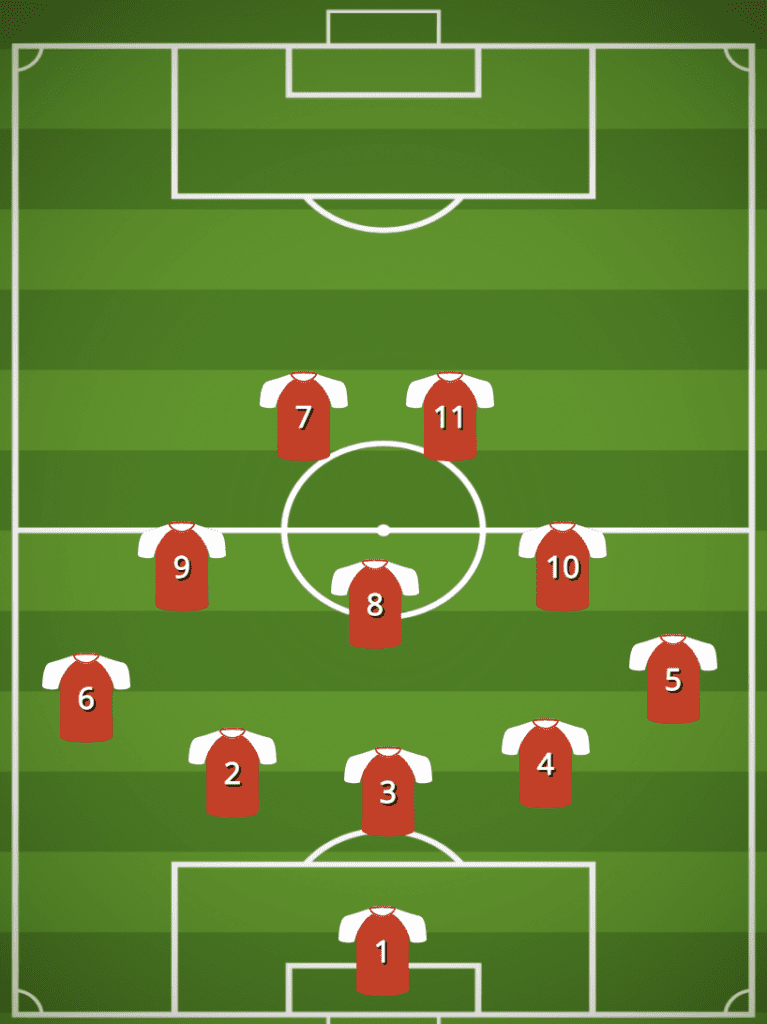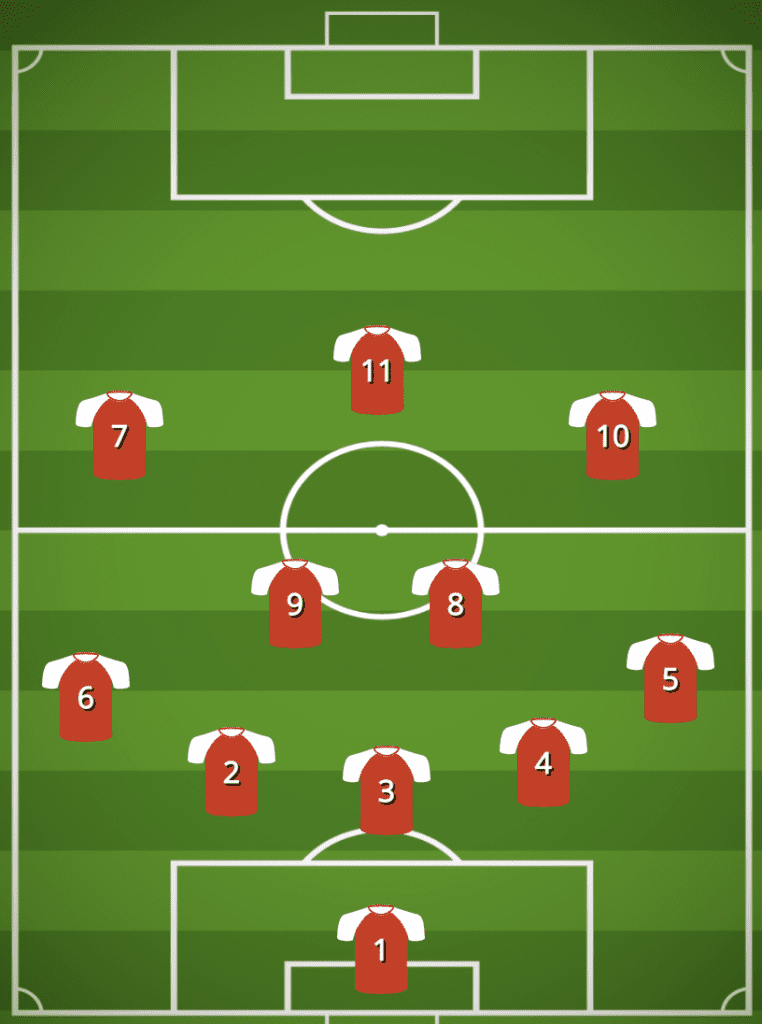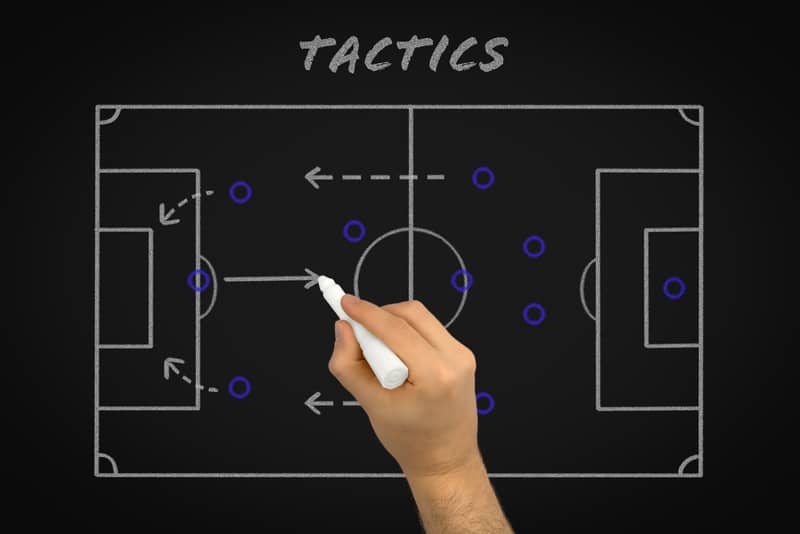
Tactics are either your favorite or worst enemy. However, they can save or destroy your club.
In every bar after a game, in every schoolyard, and in every office, you will hear soccer fans raging about their teams’ insistence on using the wrong tactics.
Everyone loves to see their team playing free-flowing soccer, but for those that follow teams that just aren’t good enough to play on the offensive, nothing beats a solid defensive formation.
It was the Italians’ art form of defensive soccer, a back-to-the wall, gritty display. Although a formation cannot exist without its players, a solid one can transform bad players into better ones.
Let’s look at the best 7 defensive formations in soccer:
7. 5-3-2 (With defensive midfielder

Stability is not achieved by anything more than a three-man defense. The defensive 5-3-2 is an excellent formation to keep the opposition at bay.
The team has three central defenders protecting their box and one defensive midfielder in front. It is up to the wingbacks for attacking width.
Two central midfielders are required to support the pitch’s center. The wingbacks should have the stamina and speed to fly up and back to provide cross-play for the lonely center-forwards.
This tactic can be used to keep things tight on the defensive, but it can limit your team’s ability to go forward.
You have a much lower chance of scoring if you are marked by the opposition as the wingbacks.
6. 5-3-2

Similar to the previous tactic, the 5-3-2 tactic differs in that the defensive middlefielder is moved forwards to central midfield to strengthen the ranks.
The wingbacks will continue to have offensive and defensive duties. However, they are expected not to lose their defensive position and to allow the three midfielders to move forward in search of goals.
The advantages of moving a man forwards in the middle of the field are that there is less chance of him being outnumbered by the opposing side, which increases ball retention.
This has an effect similar to the old phrase “the best defense is a good offense” the best way to avoid conceding a goal is to keep hold of the ball. Although it’s still a defensive tactic that is important, ball possession is an essential part of its execution.
5. 5-2-3

With our last variation of the 5-3-2 tactic, you can sense the team moving ever more cautiously forward.
This is where the team switches slightly. The once defensive midfielder moves forward, moving to the middle and then widening onto the flank to give the team more options.
Although the defense is still there, the team’s wingbacks are now firmly in place in their own halves.
They are now focusing on the forwards, rather than leaving the defense exposed. A three-pronged attack is being launched by a single striker, which focuses on feeding the ball to the wings ahead.
The striker is a part of this defensive formation. The striker holds the ball and waits for the support of the wingers.
Five defensive-minded players are holding back. The wingbacks are to pass the ball to the wingers who will cut in towards the goal, or to the hold up striker who will lay off to the incoming wings as they fly forwards.
A great formation to use for teams that have pace up front.
4. 4-1-4-1

The 4-1-4-1 tactic has many advantages, which is used often in the Premier League by weaker sides trying to stop their stronger counterparts.
The 4 man backline is a traditional British tradition, with wingbacks being more common in continental countries.
Although wingbacks may be more popular at the moment, most English players were raised in a flat-back four. Opposing teams can be terrified by a veteran left-back who pings a cross in from their byline for 90 minutes.
It is enough to stop many a winger from trying to get ahead of you by having a right-back who can close down any attacker.
This will make your goalkeeper feel extremely secure.
The icing on the cake, a defensive midfielder offering roaming cover, and you’re locked down tight with this formation. This tactic, which consists of a flat midfield with two central midfielders and two defensive wingers, is almost impossible to defeat.
3. 4-2-3-1

A soccer game is like a soccer field. It has two halves.
The tactic of ultra-conservatism is the same: 6 players are very defensively focused and move towards the other goal, looking to cause havoc.
Two defensive midfielders serve as shields, covering a well-positioned backline. Their sole purpose is to get the ball forward as fast as possible to the forwards and wingers.
This tactic is very effective if used by the right players. It is also difficult to break down because of the defensive line that encourages opponents to move forwards in numbers.
The trap is set, players are heading forward looking for a goal. However, the two forwards and the striker, if they have the ball in key forward positions can cut through any leaky defense to score the crucial goal.
2. 5-4-1

No article on defensive formations would be complete without a Libero, an Italian invention for soccer, which translates as “free”. A libero is an individual who is unbound and free from all constraints. They are the ones who roam their own territory.
The Libero will be seated behind the back four, and can roam around freely, picking up any balls and sometimes even sweeping up any other player, depending on their libero.
This tactic is very similar to the 4-1-4-1, but has a continental flair. It was something that Italian teams were able to master during the 70s/80s catenaccio-fueled soccer boom. If played well, this tactic can be very difficult to break down.
Played poorly, with a libero who doesn’t know what they are doing, and you’ve just invited disaster. The offside trap won’t work with someone standing 8 yards behind your backline, and you could find yourself playing two strikers onside.
It is often because many of the best liberos in Italy are well into their 30s before taking up the role. The awareness and positional sense required to master the position was astounding.
1. 4-4-2

It doesn’t get much more British than The Queen, The Beatles, and 4-4-2. Left-back, check. Right-back, check. Central defense monsters? Check.
Your defensive midfielder broke ranks and went looking for victims in the middle of the park. A four-man defense can help you defend against ball retention.
The midfield quartet provides both offense and defense with two strikers working as a pack in opposition’s half. They can get the ball back quickly or move it towards the goalkeeper.
This tactic is best demonstrated by Alex Ferguson’s Manchester United.
The formidable back four consisted of Gary Neville at rightback, David Beckham on right wing, Ryan Giggs and Roy Keane on the left.
This team defended from the front and won the treble, and so valued is the 4-4-2, that in times of trouble many teams simply revert back to it, safe in the knowledge that if it isn’t broke, don’t fix it.
Also, read: The Best Soccer Attacking Formations
